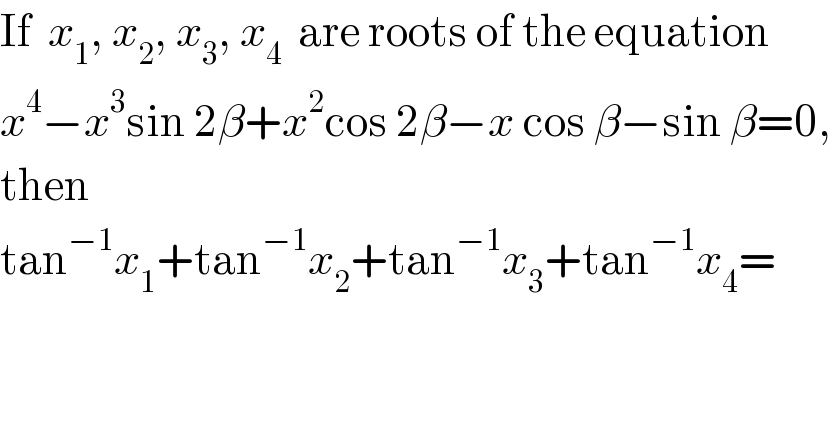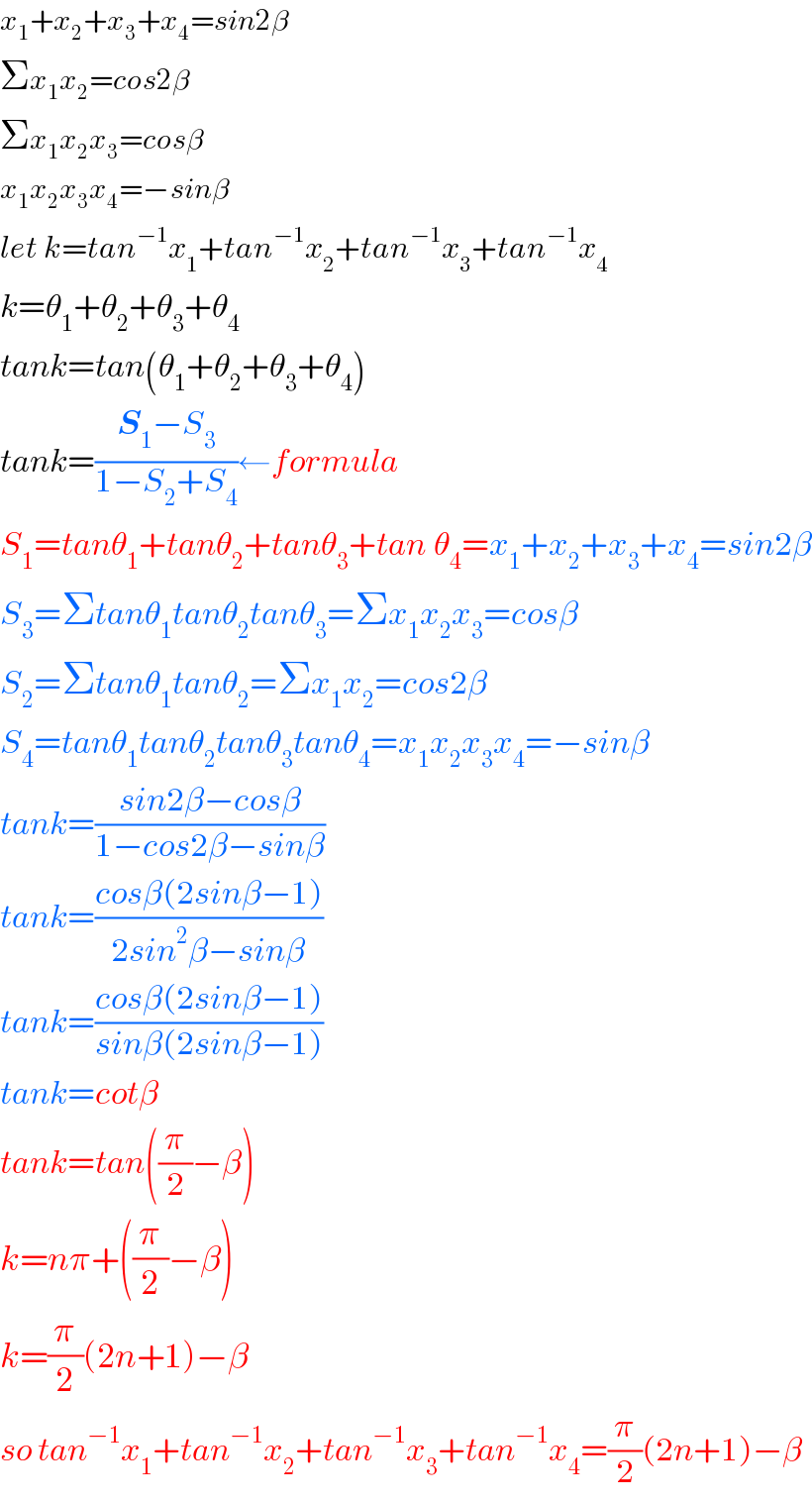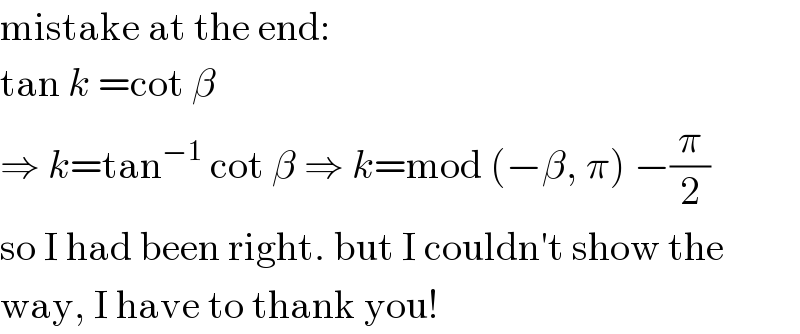
Question Number 58176 by mamah Fousséni last updated on 19/Apr/19

$$\mathrm{If}\:\:{x}_{\mathrm{1}} ,\:{x}_{\mathrm{2}} ,\:{x}_{\mathrm{3}} ,\:{x}_{\mathrm{4}} \:\:\mathrm{are}\:\mathrm{roots}\:\mathrm{of}\:\mathrm{the}\:\mathrm{equation} \\ $$$${x}^{\mathrm{4}} −{x}^{\mathrm{3}} \mathrm{sin}\:\mathrm{2}\beta+{x}^{\mathrm{2}} \mathrm{cos}\:\mathrm{2}\beta−{x}\:\mathrm{cos}\:\beta−\mathrm{sin}\:\beta=\mathrm{0}, \\ $$$$\mathrm{then} \\ $$$$\mathrm{tan}^{−\mathrm{1}} {x}_{\mathrm{1}} +\mathrm{tan}^{−\mathrm{1}} {x}_{\mathrm{2}} +\mathrm{tan}^{−\mathrm{1}} {x}_{\mathrm{3}} +\mathrm{tan}^{−\mathrm{1}} {x}_{\mathrm{4}} = \\ $$
Answered by tanmay last updated on 19/Apr/19

$${x}_{\mathrm{1}} +{x}_{\mathrm{2}} +{x}_{\mathrm{3}} +{x}_{\mathrm{4}} ={sin}\mathrm{2}\beta \\ $$$$\Sigma{x}_{\mathrm{1}} {x}_{\mathrm{2}} ={cos}\mathrm{2}\beta \\ $$$$\Sigma{x}_{\mathrm{1}} {x}_{\mathrm{2}} {x}_{\mathrm{3}} ={cos}\beta \\ $$$${x}_{\mathrm{1}} {x}_{\mathrm{2}} {x}_{\mathrm{3}} {x}_{\mathrm{4}} =−{sin}\beta \\ $$$${let}\:{k}={tan}^{−\mathrm{1}} {x}_{\mathrm{1}} +{tan}^{−\mathrm{1}} {x}_{\mathrm{2}} +{tan}^{−\mathrm{1}} {x}_{\mathrm{3}} +{tan}^{−\mathrm{1}} {x}_{\mathrm{4}} \\ $$$${k}=\theta_{\mathrm{1}} +\theta_{\mathrm{2}} +\theta_{\mathrm{3}} +\theta_{\mathrm{4}} \\ $$$${tank}={tan}\left(\theta_{\mathrm{1}} +\theta_{\mathrm{2}} +\theta_{\mathrm{3}} +\theta_{\mathrm{4}} \right) \\ $$$${tank}=\frac{\boldsymbol{{S}}_{\mathrm{1}} −{S}_{\mathrm{3}} }{\mathrm{1}−{S}_{\mathrm{2}} +{S}_{\mathrm{4}} }\leftarrow{formula} \\ $$$${S}_{\mathrm{1}} ={tan}\theta_{\mathrm{1}} +{tan}\theta_{\mathrm{2}} +{tan}\theta_{\mathrm{3}} +{tan}_{} \theta_{\mathrm{4}} ={x}_{\mathrm{1}} +{x}_{\mathrm{2}} +{x}_{\mathrm{3}} +{x}_{\mathrm{4}} ={sin}\mathrm{2}\beta \\ $$$${S}_{\mathrm{3}} =\Sigma{tan}\theta_{\mathrm{1}} {tan}\theta_{\mathrm{2}} {tan}\theta_{\mathrm{3}} =\Sigma{x}_{\mathrm{1}} {x}_{\mathrm{2}} {x}_{\mathrm{3}} ={cos}\beta \\ $$$${S}_{\mathrm{2}} =\Sigma{tan}\theta_{\mathrm{1}} {tan}\theta_{\mathrm{2}} =\Sigma{x}_{\mathrm{1}} {x}_{\mathrm{2}} ={cos}\mathrm{2}\beta \\ $$$${S}_{\mathrm{4}} ={tan}\theta_{\mathrm{1}} {tan}\theta_{\mathrm{2}} {tan}\theta_{\mathrm{3}} {tan}\theta_{\mathrm{4}} ={x}_{\mathrm{1}} {x}_{\mathrm{2}} {x}_{\mathrm{3}} {x}_{\mathrm{4}} =−{sin}\beta \\ $$$${tank}=\frac{{sin}\mathrm{2}\beta−{cos}\beta}{\mathrm{1}−{cos}\mathrm{2}\beta−{sin}\beta} \\ $$$${tank}=\frac{{cos}\beta\left(\mathrm{2}{sin}\beta−\mathrm{1}\right)}{\mathrm{2}{sin}^{\mathrm{2}} \beta−{sin}\beta} \\ $$$${tank}=\frac{{cos}\beta\left(\mathrm{2}{sin}\beta−\mathrm{1}\right)}{{sin}\beta\left(\mathrm{2}{sin}\beta−\mathrm{1}\right)} \\ $$$${tank}={cot}\beta \\ $$$${tank}={tan}\left(\frac{\pi}{\mathrm{2}}−\beta\right) \\ $$$${k}={n}\pi+\left(\frac{\pi}{\mathrm{2}}−\beta\right) \\ $$$${k}=\frac{\pi}{\mathrm{2}}\left(\mathrm{2}{n}+\mathrm{1}\right)−\beta \\ $$$${so}\:{tan}^{−\mathrm{1}} {x}_{\mathrm{1}} +{tan}^{−\mathrm{1}} {x}_{\mathrm{2}} +{tan}^{−\mathrm{1}} {x}_{\mathrm{3}} +{tan}^{−\mathrm{1}} {x}_{\mathrm{4}} =\frac{\pi}{\mathrm{2}}\left(\mathrm{2}{n}+\mathrm{1}\right)−\beta \\ $$
Commented by MJS last updated on 19/Apr/19

$$\mathrm{mistake}\:\mathrm{at}\:\mathrm{the}\:\mathrm{end}: \\ $$$$\mathrm{tan}\:{k}\:=\mathrm{cot}\:\beta \\ $$$$\Rightarrow\:{k}=\mathrm{tan}^{−\mathrm{1}} \:\mathrm{cot}\:\beta\:\Rightarrow\:{k}=\mathrm{mod}\:\left(−\beta,\:\pi\right)\:−\frac{\pi}{\mathrm{2}} \\ $$$$\mathrm{so}\:\mathrm{I}\:\mathrm{had}\:\mathrm{been}\:\mathrm{right}.\:\mathrm{but}\:\mathrm{I}\:\mathrm{couldn}'\mathrm{t}\:\mathrm{show}\:\mathrm{the} \\ $$$$\mathrm{way},\:\mathrm{I}\:\mathrm{have}\:\mathrm{to}\:\mathrm{thank}\:\mathrm{you}! \\ $$
Commented by tanmay last updated on 19/Apr/19

$${thank}\:{you}\:{sir}..{i}\:{made}\:{mistake}\:{at}\:{the}\:{last}\:{step} \\ $$$${but}\:{duly}\:{rectified}\:{sir}... \\ $$
